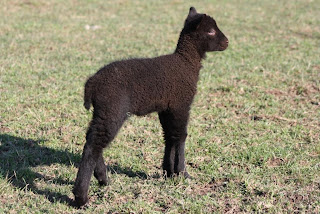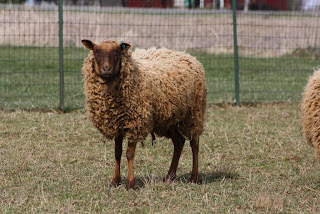It’s fiber festival and the time when we get a lot of questions about our fiber and Shetlands. I thought I would take some time to answer a few questions ahead of time so I don’t screw up the answer in person like I usually do.
Q: Why is your Shetland fiber so much better than much of what is on the market?
Q: How important is nutrition to fleece quality?
A: It’s important, but not nearly as important as bloodlines and proper selection. You can add two to three microns to a Shetland’s fleece through heavy graining, and you can subtract more than that by not feeding them properly, but crimp, silkiness, consistency, and proper lock structure are all inherent in the design of the animal. Good fleeces are the result of breeding. Long fleeces are not the result of overfeeding any more than short ones are the result of underfeeding.
Q: How important are micron tests?
A: Micron tests are one tool that we use to evaluate fleeces, but arguably the least important. One of the reasons for that is that nutrition can and does influence the results. I’ve experimented with that and I can say that with complete certainty. But, for the average, properly fed flock, they are an important tool. When you start comparing between flocks; that’s when things get misleading. That’s why I never buy sheep based on micron results. I can tell certain things about a fleece just by looking at it, and I can tell even more by feeling it. More importantly, good customers usually pick out our best fleeces pretty consistently, and those fleeces aren’t always our finest.
Q: You have a weird fleece grading system, can you explain it?
A: We use the grading chart that we created in the Fine Fleece Shetland Fleece Association, which is an adaptation of the one Jamieson and Smith uses in the UK. The main difference is that we incorporated micron values into our grading system, which J & S does not do. We did that because J & S has one guy who grades the entire Shetland wool clip, whereas, we have no similar method in North America. It’s not perfect, but it’s the best we can do without having one experienced, central figure doing the grading.
Q: Can you explain what Superfine means? Merino’s are finer than Shetland, and yet you are using the term superfine, which is somewhat misleading.
A: Superfine is a term used by Jamieson and Smith to describe the finest of Shetland fleeces. It is their top grade. We adopted that terminology for our flock so that people could compare our fleeces in a manner similar to what J & S uses. The FFSSA currently defines Superfine as less than 25 microns, but with low variability. That means very little tip and minimal guard hair. We didn’t invent the grading system we use; it’s the same methodology that J & S uses in the UK with the addition of micron values. There’s no real way to use an identical system, but the spirit is there. As an example, if we have a 24.5 micron fleece but it is more intermediate because it has noticeable guard hair (meaning the CV will be higher), it doesn’t get the superfine grade even though the average would qualify. It’s a holistic approach to fleece grading, and not as easy as just looking at the average micron, but it’s more effective and more useful to the end user.
Fine is the next grade, and that works the same way except that the average micron values are higher (but still less than 30 microns).
In short, superfine is a Jamieson and Smith convention that we are using because we think it captures the correct qualities of a Shetland fleece. A merino is a commercial animal, which requires a commercial standard. I know it’s confusing, but we are trying to align the Shetland breed with the terminology that made them famous in their native land. They were known as the finest of the British breed as far back as the 18th century (before there were Merino’s in the UK), and we are trying to maintain the historical terminology as much as possible. The term Superfine means the finest that was available at that time in history. Shetlands aren’t the finest available today, but the other fleece properties are still there, and in the interest of historical accuracy, we are maintaining the same phrasing.
Q: None of your fleeces are double coated. Why is that?
A: We have tried many bloodlines and fleece types, but both our experience and literature suggest that the best Shetland fleeces tend toward the kindly type. You do not see the long, flowing double coated fleeces in the UK like you do here. That’s an Americanization of the original breed. You might see some level of double coating over there, but certainly not the extremes we see here. And the reason for that is that it doesn’t meet the historical breed standard. It’s okay if people breed for double coating, but those animals aren’t superfine. The inner coat might be, but that’s only part of the equation. Unless you are separating the coats and marketing them separately, you have no business slapping that kind of label on them. Those sheep have superfine inner coats combined with coarse and longer outer coats. That would be like mixing gourmet coffee with cheap swill out of the vending machine and calling it gourmet. Can a double coated fleece still be called “fine?” Yes. It all depends on how severe the condition is. We have ways of determining that. Can a double coated Shetland also be called “superfine?” The simple answer is yes, but with a similar caveat.
Q: I’ve seen Shetland fleeces that were low in micron, and silky soft, but that were fairly long. How can that be?
A: Soft can be a function of silky, which is completely different than fine. But a fleece like you are describing can also be quite fine. Be that as it may, it is longer because of the guard hair, which is not fine (technically, it could be less than 30 microns, but typically isn’t). You might prefer that type of fleece, and I would not try and talk you out of it. Those fleeces are often great for spinners because of the length and silkiness, but don’t be fooled into thinking you have something that is “next to skin” capable. Those long guard hairs will be prickly, regardless of their silkiness (which is a function of how the fiber’s scales overlap



















































